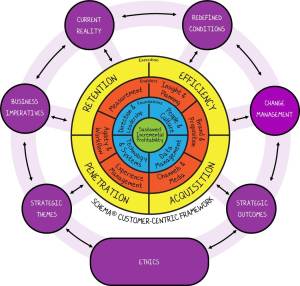Designing and executing a customer-centric business model requires end to end organisational alignment. Customer-centric capability development cannot take place in isolation to the rest of the business. The customer-centric journey requires a clear quantified understanding of current organisational capability across all 14 capability areas of the SCHEMA® Customer Management framework in the centre of the REAP Customer-Centric Blueprint below. As important as an understanding of current customer management capability is, so too is an understanding of the capability to which the organisation aspires.
Each week I’ll address another single capability area, sharing with you the Transformation Intent to which your organisation should commit to, as well as ‘What Good Looks Like’ for those organisations that have achieved a fairly high level of maturity in the respective capability area.
The REAP Customer-Centric Organisation Blueprint®
This week we are dealing with Retention which is one of the four Execution capability areas represented. The Execution layer relates to the capabilities and control levers needed to optimise customer value and include Retention, Efficiency (understanding cost to serve), Acquisition and Penetration (customer development, cross-sell and up-sell) – collectively referred to as REAP. These are capabilities and initiatives that can be optimised in the short term.
These capabilities support your ability to implement your chosen customer strategies and rely on the fundamental building blocks (Foundations) as well as the Enabling capabilities already discussed in Part 1 to 10 of this series of blog posts.
Each of the four Execution capability areas is made up of sub-components. In developing Retention capabilities it is important to understand the drivers that create and maintain loyalty as well as the factors that destroy it, important to consider how to retain through business as usual, important to consider pro-active retention activity and how to best manage dissatisfaction. Each of these areas is addressed in separate, individual blog posts.
Transformation Intent – Retention
“Retention is all about understanding your customer base and the drivers that create and maintain loyalty as well as the factors that destroy it. Coupled with this is the need to consistently deliver on your promise while ensuring that over-delivery is balanced against the overriding goal of doing just enough to ensure repurchase. A retention strategy also demands that you are pro-active with your customers, monitoring them for signs of defection and implementing constructive plans to generate customer commitment to repurchase. Should customers become dissatisfied, the right flows of communication alert you so that the issues can be addressed promptly and consistently, whilst solving the problem at a root cause level.”
What Good Looks Like – Understanding Retention
- The nature of customers who stay for longer than average is understood along with the balance of what drives this loyalty between brand affinity and more tangible market / physical factors. The correlation between stated satisfaction and demonstrated transaction loyalty is also fully understood.
- Customer (as opposed to product) loss is defined and always detected as soon as it is possible to do so. The reasons why customers leave and the stages of their relationship at which they are most likely to leave are understood.
- Clear definitions and monitoring are also in place around value decay / dormancy, why these customers have not left completely and why some of them re-activate at a later stage.
For more insight into customer-centric business model innovation as well as more insight into this particular area of the REAP Customer-Centric Blueprint, please see my book “The Customer-Centric Blueprint’ – http://amzn.to/ZILg4y
Filed under: 21st Century Organisation, Best Practice, Business Models, Change Management, Competitive Advantage, Customer Centricity, Customer Experience, customer management, Customer Retention, Customer Strategy, Frameworks, Innovation, Leadership, Measurement, Sustainable Business Performance Tagged: | 21st century organisations, Big Thinking, business innovation, business performance, business strategy, capability development, company strategy, CRM, customer experience, customer experience management, Customer Value Management, Inspiration, organisational alignment, Retention, Sustainability, thinking customer




